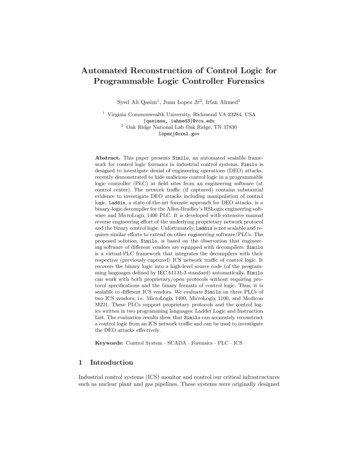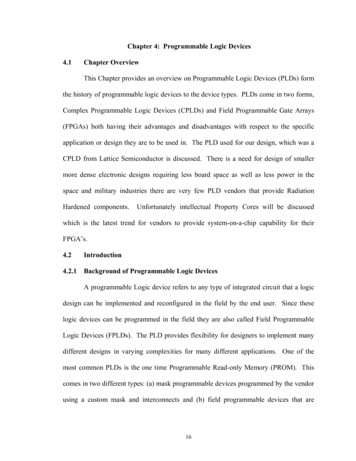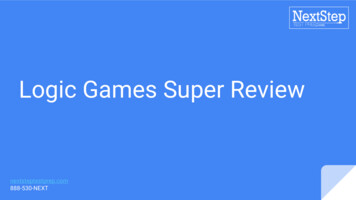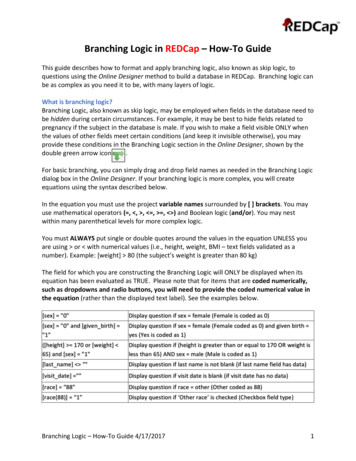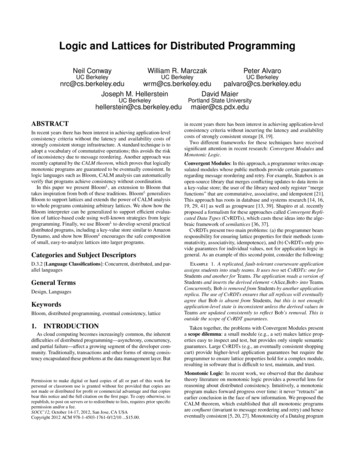
Transcription
Logic and Lattices for Distributed ProgrammingNeil ConwayWilliam R. MarczakPeter AlvaroUC BerkeleyUC BerkeleyUC aro@cs.berkeley.eduJoseph M. HellersteinDavid MaierUC Berkeleyhellerstein@cs.berkeley.eduABSTRACTIn recent years there has been interest in achieving application-levelconsistency criteria without the latency and availability costs ofstrongly consistent storage infrastructure. A standard technique is toadopt a vocabulary of commutative operations; this avoids the riskof inconsistency due to message reordering. Another approach wasrecently captured by the CALM theorem, which proves that logicallymonotonic programs are guaranteed to be eventually consistent. Inlogic languages such as Bloom, CALM analysis can automaticallyverify that programs achieve consistency without coordination.In this paper we present BloomL , an extension to Bloom thattakes inspiration from both of these traditions. BloomL generalizesBloom to support lattices and extends the power of CALM analysisto whole programs containing arbitrary lattices. We show how theBloom interpreter can be generalized to support efficient evaluation of lattice-based code using well-known strategies from logicprogramming. Finally, we use BloomL to develop several practicaldistributed programs, including a key-value store similar to AmazonDynamo, and show how BloomL encourages the safe compositionof small, easy-to-analyze lattices into larger programs.Categories and Subject DescriptorsD.3.2 [Language Classifications]: Concurrent, distributed, and parallel languagesGeneral TermsDesign, LanguagesKeywordsBloom, distributed programming, eventual consistency, lattice1.INTRODUCTIONAs cloud computing becomes increasingly common, the inherentdifficulties of distributed programming—asynchrony, concurrency,and partial failure—affect a growing segment of the developer community. Traditionally, transactions and other forms of strong consistency encapsulated these problems at the data management layer. ButPermission to make digital or hard copies of all or part of this work forpersonal or classroom use is granted without fee provided that copies arenot made or distributed for profit or commercial advantage and that copiesbear this notice and the full citation on the first page. To copy otherwise, torepublish, to post on servers or to redistribute to lists, requires prior specificpermission and/or a fee.SOCC’12, October 14-17, 2012, San Jose, CA USACopyright 2012 ACM 978-1-4503-1761-0/12/10 . 15.00.Portland State Universitymaier@cs.pdx.eduin recent years there has been interest in achieving application-levelconsistency criteria without incurring the latency and availabilitycosts of strongly consistent storage [8, 19].Two different frameworks for these techniques have receivedsignificant attention in recent research: Convergent Modules andMonotonic Logic.Convergent Modules: In this approach, a programmer writes encapsulated modules whose public methods provide certain guaranteesregarding message reordering and retry. For example, Statebox is anopen-source library that merges conflicting updates to data items ina key-value store; the user of the library need only register “mergefunctions” that are commutative, associative, and idempotent [21].This approach has roots in database and systems research [14, 16,19, 29, 41] as well as groupware [13, 39]. Shapiro et al. recentlyproposed a formalism for these approaches called Convergent Replicated Data Types (CvRDTs), which casts these ideas into the algebraic framework of semilattices [36, 37].CvRDTs present two main problems: (a) the programmer bearsresponsibility for ensuring lattice properties for their methods (commutativity, associativity, idempotence), and (b) CvRDTs only provide guarantees for individual values, not for application logic ingeneral. As an example of this second point, consider the following:Example 1. A replicated, fault-tolerant courseware applicationassigns students into study teams. It uses two set CvRDTs: one forStudents and another for Teams. The application reads a version ofStudents and inserts the derived element Alice,Bob into Teams.Concurrently, Bob is removed from Students by another applicationreplica. The use of CvRDTs ensures that all replicas will eventuallyagree that Bob is absent from Students, but this is not enough:application-level state is inconsistent unless the derived values inTeams are updated consistently to reflect Bob’s removal. This isoutside the scope of CvRDT guarantees.Taken together, the problems with Convergent Modules presenta scope dilemma: a small module (e.g., a set) makes lattice properties easy to inspect and test, but provides only simple semanticguarantees. Large CvRDTs (e.g., an eventually consistent shoppingcart) provide higher-level application guarantees but require theprogrammer to ensure lattice properties hold for a complex module,resulting in software that is difficult to test, maintain, and trust.Monotonic Logic: In recent work, we observed that the databasetheory literature on monotonic logic provides a powerful lens forreasoning about distributed consistency. Intuitively, a monotonicprogram makes forward progress over time: it never “retracts” anearlier conclusion in the face of new information. We proposed theCALM theorem, which established that all monotonic programsare confluent (invariant to message reordering and retry) and henceeventually consistent [5, 20, 27]. Monotonicity of a Datalog program
is straightforward to determine conservatively from syntax, so theCALM theorem provides the basis for a simple analysis of theconsistency of distributed programs. We concretized CALM intoan analysis procedure for Bloom, a Datalog-based language fordistributed programming [2, 9].The original formulation of CALM and Bloom only verifiedthe consistency of programs that compute sets of facts that growover time (“set monotonicity”); that is, “forward progress” wasdefined according to set containment. As a practical matter, this isoverly conservative: it precludes the use of common monotonicallyincreasing constructs such as timestamps and sequence numbers.Example 2. In a quorum voting service, a coordinator countsthe number of votes received from participant nodes; quorum isreached once the number of votes exceeds a threshold. This is clearlymonotonic: the vote counter increases monotonically, as does thethreshold test (count(votes) k) which “grows” from False toTrue. But both of these constructs (upward-moving mutable variables and aggregates) are labeled non-monotonic by the originalCALM analysis.The CALM theorem obviates any scoping concerns for convergent monotonic logic, but it presents a type dilemma. Sets are theonly data type amenable to CALM analysis, but the programmermay have a more natural representation of a monotonically growingphenomenon. For example, a monotonic counter is more naturallyrepresented as a growing integer than a growing set. This dilemmaleads either to false negatives in CALM analysis and over-use ofcoordination, or to idiosyncratic set-based implementations that canbe hard to read and maintain.1.1BloomL : Logic And LatticesWe address the two dilemmas above with BloomL , an extension toBloom that incorporates a semilattice construct similar to CvRDTs.We present this construct in detail below, but the intuition is thatBloomL programs can be defined over arbitrary types—not just sets—as long as they have commutative, associative, and idempotent mergefunctions (“least upper bound”) for pairs of items. Such a mergefunction defines a partial order for its type. This generalizes Bloom(and traditional Datalog), which assumes a fixed merge function (setunion) and partial order (set containment).BloomL provides three main improvements in the state of the artof both Bloom and CvRDTs:1. BloomL solves the type dilemma of logic programming: CALManalysis in BloomL can assess monotonicity for arbitrary lattices, making it significantly more liberal in its ability to testfor confluence. BloomL can validate the coordination-free useof common constructs like timestamps and sequence numbers.2. BloomL solves the scope dilemma of CvRDTs by providingmonotonicity-preserving mappings between lattices via morphisms and monotone functions. Using these mappings, theper-component monotonicity guarantees offered by CvRDTscan be extended across multiple items of lattice type. Thiscapability is key to the CALM analysis described above. It isalso useful for proving the monotonicity of sub-programs evenwhen the whole program is not designed to be monotonic.3. For efficient incremental execution, we extend the standardDatalog semi-naive evaluation scheme [7] to support lattices.We also describe how to extend an existing Datalog runtimeto support lattices with relatively minor changes.1.2OutlineThe remainder of the paper proceeds as follows. Section 2 provides background on Bloom and CALM. In Section 3 we introduceBloomL , including cross-lattice morphisms and monotone functions.We detail BloomL ’s built-in lattice types and show how developerscan define new lattices. We also describe how the CALM analysisextends to BloomL . In Section 4, we describe how we modified theBloom runtime to support BloomL .In Sections 5 and 6, we present two case studies. First, we useBloomL to implement a distributed key-value store that supportseventual consistency, object versioning using vector clocks, and quorum replication. Second, we revisit the simple e-commerce scenariopresented by Alvaro et al. in which clients interact with a replicatedshopping cart service [2]. We show how BloomL can be used tomake the “checkout” operation monotonic and confluent, despitethe fact that it requires aggregation over a distributed data set.2.BACKGROUNDIn this section, we review the Bloom programming language andthe CALM program analysis. We present a simple program forwhich the CALM analysis over sets yields unsatisfactory results.2.1BloomBloom programs are bundles of declarative statements about collections of facts (tuples). An instance of a Bloom program performscomputation by evaluating its statements over the contents of itslocal database. Instances communicate via asynchronous messaging.An instance of a Bloom program proceeds through a series oftimesteps, each containing three phases.1 In the first phase, inboundevents (e.g., network messages) are received and represented asfacts in collections. In the second phase, the program’s statementsare evaluated over local state to compute all the additional factsthat can be derived from the current collection contents. In somecases (described below), a derived fact is intended to achieve a “sideeffect,” such as modifying local state or sending a network message.These effects are deferred during the second phase of the timestep;the third phase is devoted to carrying them out.The initial implementation of Bloom, called Bud, allows Bloomlogic to be embedded inside a Ruby program. Figure 1 shows aBloom program represented as an annotated Ruby class. A smallamount of Ruby code is needed to instantiate the Bloom programand begin executing it; more details are available on the Bloomlanguage website [9].2.1.1Data ModelThe Bloom data model is based on collections. A collection isan unordered set of facts, akin to a relation in Datalog. The Budprototype adopts the Ruby type system rather than inventing its own;hence, a fact in Bud is just an array of immutable Ruby objects.Each collection has a schema, which declares the structure (columnnames) of the facts in the collection. A subset of the columns in acollection form its key: as in the relational model, the key columnsfunctionally determine the remaining columns. The collections usedby a Bloom program are declared in a state block. For example,line 5 of Figure 1 declares a collection named link with threecolumns, two of which form the collection’s key. Ruby is a dynamically typed language, so keys and values in Bud can hold arbitraryRuby objects.Bloom provides several collection types to represent differentkinds of state (Table 1). A table stores persistent data: if a fact1There is a declarative semantics for Bloom [1, 4], but for the sakeof exposition we describe the language operationally here.
1245678class ShortestPathsinclude Budstate dotable :link, [:from, :to] [:cost]scratch :path, [:from, :to, :next hop, :cost]scratch :min cost, [:from, :to] [:cost]end1011121314bloom dopath link { l [l.from, l.to, l.to, l.cost]}path (link*path).pairs(:to :from) do l,p [l.from, p.to, l.to, l.cost p.cost]end161718min cost path.group([:from, :to], min(:cost))endendFigure 1: All-pairs shortest paths in Bloom.appears in a table, it remains in the table in future timesteps (unlessit is explicitly removed). A scratch contains transient data—thecontent of scratch collections is emptied at the start of each timestep.Scratches are akin to SQL views: they are often useful as a way toname intermediate results or as a “macro” construct to enable codereuse. A channel allows communication between Bloom instances.The schema of a channel has a distinguished location specifiercolumn (prefixed with “@”). When a fact is derived for a channelcollection, it is sent to the remote Bloom instance at the addressgiven by the location specifier.2.1.2StatementsEach Bloom statement has one or more input collections and asingle output collection. A statement takes the form: collection-identifier op collection-expression The left-hand side (lhs) is the name of the output collection and theright-hand side (rhs) is an expression that produces a collection. Astatement defines how the input collections are transformed beforebeing included (via set union) in the output collection. Bloom allows the usual relational operators to be used on the rhs (selection,projection, join, grouping, aggregation, and negation), although itadopts a syntax intended to be more familiar to imperative programmers. In Figure 1, line 11 demonstrates projection, lines 12–14perform a join between link and path using the join predicatelink.to path.from followed by a projection to four attributes,and line 16 shows grouping and aggregation. Bloom statementsappear in one or more bloom blocks, which group together semantically related statements to aid readability.Bloom provides several operators that determine when the rhswill be merged into the lhs (Table 2). The operator performsstandard logical deduction: that is, the lhs and rhs are true at thesame timestep. The and - operators indicate that facts will beadded to or removed from the lhs collection at the beginning of thenext timestep. The operator specifies that the rhs will be mergedinto the lhs collection at some non-deterministic future time. Thelhs of a statement that uses must be a channel; the operatorcaptures asynchronous messaging.Bloom allows recursion—i.e., the rhs of a statement can referencethe lhs collection, either directly or indirectly. As in Datalog, certainconstraints must be adopted to ensure that programs with recursivestatements have a sensible interpretation. For deductive statements( operator), we require that programs be syntactically stratified [6]:cycles through negation or aggregation are not allowed [4].NametablescratchchannelBehaviorPersistent storage.Transient storage.Asynchronous communication. A fact derivedinto a channel appears in the database of aremote Bloom instance at a non-deterministicfuture time.Table 1: Bloom collection types.Op Namemerge deferred merge -deferred delete async mergeMeaninglhs includes the content of rhs in thecurrent timestep.lhs will include the content of rhs inthe next timestep.lhs will not include the content of rhsin the next timestep.(Remote) lhs will include the contentof the rhs at some non-deterministicfuture timestep.Table 2: Bloom operators.2.2CALM AnalysisWork on deductive databases has long drawn a distinction between monotonic and non-monotonic logic programs. Intuitively, amonotonic program only computes more information over time—itnever “retracts” a previous conclusion in the face of new evidence.In Bloom (and Datalog), a simple conservative test for monotonicity is based on program syntax: selection, projection, and join aremonotonic, while aggregation, negation, and deletion are not.The CALM theorem connects the theory of monotonic logicwith the practical problem of distributed consistency [2, 20]. Allmonotonic programs are “eventually consistent” or confluent: forany given input, all program executions result in the same final stateregardless of network non-determinism [5, 27]. Hence, monotoniclogic is a useful building block for loosely consistent distributedprogramming.According to the CALM theorem, distributed inconsistency mayonly occur at a point of order: a program location where an asynchronously derived value is consumed by a non-monotonic operator [2]. This is because asynchronous messaging results in nondeterministic arrival order, and non-monotonic operators may produce different conclusions when evaluated over different subsets oftheir inputs. For example, consider a Bloom program consisting of apair of collections A and B (both fed by asynchronous channels) anda rule that sends a message whenever an element of A arrives that isnot in B. This program is non-monotonic and exhibits non-confluentbehavior: the messages sent by the program will depend on the orderin which the elements of A and B arrive.We have implemented a conservative static program analysis inBloom that follows directly from the CALM theorem. Programs thatare free from non-monotonic constructs are “blessed” as confluent:producing the same output on different runs or converging to thesame state on multiple distributed replicas. Otherwise, programsare flagged as potentially inconsistent. To achieve consistency, theprogrammer either needs to rewrite their program to avoid the useof non-monotonicity or introduce a coordination protocol to ensurethat a consistent ordering is agreed upon at each of the program’spoints of order. Coordination protocols increase latency and reduceavailability in the event of network partitions, so in this paper wefocus on coordination-free designs—that is, monotonic programs.
12QUORUM SIZE 5RESULT ADDR "example.org"12QUORUM SIZE 5RESULT ADDR "example.org"45class QuorumVoteinclude Bud45class QuorumVoteLinclude Bud789101112141516171819state dochannelchanneltablescratchend:vote chn, [:@addr, :voter id]:result chn, [:@addr]:votes, [:voter id]:cnt, [] [:cnt]bloom dovotes vote chn { v [v.voter id]}cnt votes.group(nil, count(:voter id))result chn cnt { c [RESULT ADDR] if c QUORUM SIZE}endendFigure 2: A non-monotonic Bloom program that waits for aquorum of votes to be received.2.2.1ADDING LATTICES TO BLOOMThis section introduces BloomL , an extension to Bloom that allows monotonic programs to be written using arbitrary lattices. Webegin by reviewing the algebraic properties of lattices, monotonefunctions, and morphisms. We then introduce the basic concepts ofBloomL and detail the built-in lattices provided by the language. Wealso show how users can define their own lattice types.When designing BloomL , we decided to extend Bloom to include support for lattices rather than building a new language fromscratch. Hence, BloomL is backward compatible with Bloom andwas implemented with relatively minor changes to the Bud runtime.We describe how code written using lattices can interoperate withtraditional Bloom collections in Section 3.5.3.115161718192021state dochannelchannellsetlmaxlboolend:vote chn, [:@addr, :voter id]:result chn, [:@addr]:votes:cnt:quorum donebloom dovotescntquorum doneresult chnendend vote chn { v v.voter id}votes.sizecnt.gt eq(QUORUM SIZE)quorum done.when true { [RESULT ADDR] }Figure 3: A monotonic BloomL program that waits for a quorum of votes to be received.Limitations Of Set MonotonicityThe original formulation of the CALM theorem considered onlyprograms that compute more facts over time—that is, programswhose sets grow monotonically. Many distributed protocols makeprogress over time but their notion of “progress” is often difficultto represent as a growing set of facts. For example, consider theBloom program in Figure 2. This program receives votes from oneor more clients (not shown) via the vote chn channel. Once atleast QUORUM SIZE votes have been received, a message is sent to aremote node to indicate that quorum has been reached (line 17). Thisprogram resembles a “quorum vote” subroutine that might be usedby an implementation of Paxos [24] or quorum replication [18].Intuitively, this program makes progress in a semantically monotonic fashion: the set of received votes grows and the size of thevotes collection can only increase, so once a quorum has beenreached it will never be retracted. Unfortunately, the current CALManalysis would regard this program as non-monotonic because itcontains a point of order: the grouping operation on line 16.To solve this problem, we need to introduce a notion of programvalues that “grow” according to a partial order other than set containment. We do this by extending Bloom to operate over arbitrarylattices rather than just the set lattice.3.78910111213DefinitionsA bounded join semilattice is a triple hS , t, i, where S is a set,t is a binary operator (called “join” or “least upper bound”), and is an element of S (called “bottom”). The t operator is associative,commutative, and idempotent. The t operator induces a partial order S on the elements of S : x S y if xty y. Note that although S isonly a partial order, the least upper bound is defined for all elementsx, y S . The distinguished element is the smallest element in S :x t x for every x S . For brevity, we use the term “lattice” tomean “bounded join semilattice” in the rest of this paper. We usethe informal term “merge function” to mean “least upper bound.”A monotone function is a function f : S T such that S , T arepartially ordered sets (posets) and a, b S : a S b f (a) Tf (b). That is, f maps elements of S to elements of T in a mannerthat respects the partial orders of both posets.2A morphism from lattice hX, tX , X i to lattice hY, tY , Y i is afunction g : X Y such that g( X ) Y and a, b X : g(a tXb) g(a) tY g(b). Intuitively, g maps elements of X to elements ofY in a way that preserves the lattice properties. Note that morphismsare monotone functions but the converse is not true in general.3.2Language ConstructsBloomL allows both lattices and collections to represent state. Alattice is analogous to a collection type in Bloom, while a latticeelement corresponds to a particular collection. For example, thelset lattice is similar to the table collection type provided byBloom; an element of the lset lattice is a particular set. In theterminology of object-oriented programming, a lattice is a class thatobeys a certain interface and an element of a lattice is an instance ofthat class. Figure 3 contains an example BloomL program.As with collections, the lattices used by a BloomL program aredeclared in a state block. More precisely, a state block declarationintroduces an identifier that is associated with a lattice element; overtime, the binding between identifiers and lattice elements is updatedto reflect state changes in the program. For example, line 10 ofFigure 3 declares an identifier votes that is mapped to an elementof the lset lattice. As more votes are received, the lattice elementassociated with the votes identifier changes (it moves “upward” inthe lset lattice). When a lattice identifier is declared, it is initiallybound to , the smallest element in the lattice. For example, anlset lattice initially contains the empty set.2To simplify the presentation, these definitions assume that monotone functions and morphisms are unary. BloomL supports monotonefunctions and morphisms with any number of arguments.
NamelboolDescriptionBoolean lattice(false true)Max over anordered domainLeast element ( )falseMerge(a, b)a bMorphismswhen true(&blk) v max(a, b)lminMin over anordered domain min(a, b)lsetSet of valuesempty seta blpsetSet of nonnegative numbersempty seta blbagMultiset of valuesempty multiseta blmapMap from keys tolattice valuesempty mapsee textgt(n) lboolgt eq(n) lbool (n) lmax (n) lmaxlt(n) lboollt eq(n) lbool (n) lmin (n) lminintersect(lset) lsetproject(&blk) lsetproduct(lset) lsetcontains?(v) lboolintersect(lpset) lpsetproject(&blk) lpsetproduct(lpset) lpsetcontains?(v) lboolintersect(lbag) lbagproject(&blk) lbagmultiplicity(v) lmaxcontains?(v) lbool (lbag) lbagintersect(lmap) lmapproject(&blk) lmapkey set() lsetat(v) any-latticekey?(v) lboollmaxMonotone functionssize() lmaxsize() lmaxsum() lmaxsize() lmaxsize() lmaxTable 3: Built-in lattices in BloomL . Note that v denotes a Ruby value, n denotes a number, and blk indicates a Ruby code block(anonymous function).3.2.1StatementsLStatements take the same form in both Bloom and Bloom : identifier op expression The identifier on the lhs can refer to either a set-oriented collectionor a lattice element. The expression on the rhs can contain bothtraditional relational operators (applied to Bloom collections) andmethods invoked on lattices. Lattice methods are similar to methodsin an object-oriented language and are invoked using the standardRuby method invocation syntax. For example, line 17 of Figure 3invokes the size method on an element of the lset lattice.If the lhs is a lattice, the statement’s operator must be either or (instantaneous or deferred deduction, respectively). The meaningof these operators is that, at either the current or the followingtimestep, the lhs identifier will take on the result of applying thelattice’s least upper bound to the lhs and rhs lattice elements. Theintuition remains the same as in Bloom: the rhs value is “mergedinto” the lhs lattice, except that the semantics of the merge operationare defined by the lattice’s least upper bound operator. We requirethat the lhs and rhs refer to a lattice of the same type.BloomL does not support deletion ( - operator) for lattices. Lattices do not directly support asynchronous communication (via the operator) but lattice elements can be embedded into facts thatappear in channels (Section 3.5.2).3.2.2Lattice MethodsBloomL statements compute values over lattices by invokingmethods on lattice elements. Just as a subset of the relational algebrais monotonic, some lattice methods are monotone functions (asdefined in Section 3.1). A monotone lattice method guarantees that,if the lattice on which the method is invoked grows (according tothe lattice’s partial order), the value returned by the method willgrow (according to the return value’s lattice type). For example, thesize method provided by the lset lattice is monotone becauseas more elements are added to the set, the size of the set increases.Intuitively, a lattice’s monotone methods constitute a “safe” interfaceof operations that can be invoked in a distributed setting withoutrisk of inconsistency.A lattice method’s signature indicates its monotonicity properties.BloomL distinguishes between methods that are monotone and asubset of monotone methods that are morphisms. Section 3.1 definesthe properties that a morphism must satisfy, but the intuition is thata morphism on lattice T can be distributed over T ’s least upperbound. For example, the size method of the lset lattice is nota morphism. To see why, consider two elements of the lset lattice, {1, 2} and {2, 3}. The size method is not a morphism becausesize({1, 2} tlset {2, 3}) , size({1, 2}) tlmax size({2, 3}). Morphismscan be evaluated more efficiently than monotone methods, as wediscuss in Section 4.1.Lattices can also define non-monotonic methods. Using a nonmonotonic lattice method is analogous to using a non-monotonicrelational operator in Bloom: the Bud interpreter stratifies the program to ensure that the input value is computed to completion beforeallowing the non-monotonic method to be invoked. BloomL encourages developers to minimize the use of non-monotonic constructs:as the CALM analysis suggests, non-monotonic reasoning may needto be augmented with coordination to ensure consistent results.Every lattice defines a non-monotonic reveal method that returns a representation of the lattice element as a plain Ruby value.For example, the reveal method on an lmax lattice returns a Rubyinteger. This method is non-monotonic because once the underlying Ruby value has been extracted from the lattice, BloomL cannotensure that subsequent code uses the value in a monotonic fashion.
3.3Built-in LatticesTable 3 lists the lattices included with BloomL . The built-in lattices provide support for several common notions of “progress”: apredicate that moves from false to true (lbool), a numeric valuethat strictly increases or strictly decreases (lmax and lmin, respectively), and various kinds of collections that grow over time (lset,lpset, lbag, and lmap). The behavior of most of the lattice methods should be unsurprising, so we do not describe every method inthis section.The lbool lattice represents conditions that, once satisfied, remain satisfied. For example, the gt morphism on the lmax latticetakes a numeric argument n and returns an lbool; once the lmaxexceeds n, it will remain n. The when true morphism takes aRuby block; if the lbool element has the value true, when truereturns the result of evaluating the block. For example, see line 19in Figure 3. when true is similar to an “if” statement.3The collection-like lattices support familiar operations such asunion, intersection, and testing for the presence of an element in thecollection. The project morphism takes a code block and forms anew collection by applying the code block to each element of theinput collection.
logic to be embedded inside a Ruby program. Figure 1 shows a Bloom program represented as an annotated Ruby class. A small amount of Ruby code is needed to instantiate the Bloom program and begin executing it; more details are available on the Bloom language website [9]. 2.1.1 Data Model The Bloom data model is based on collections. A collection is








